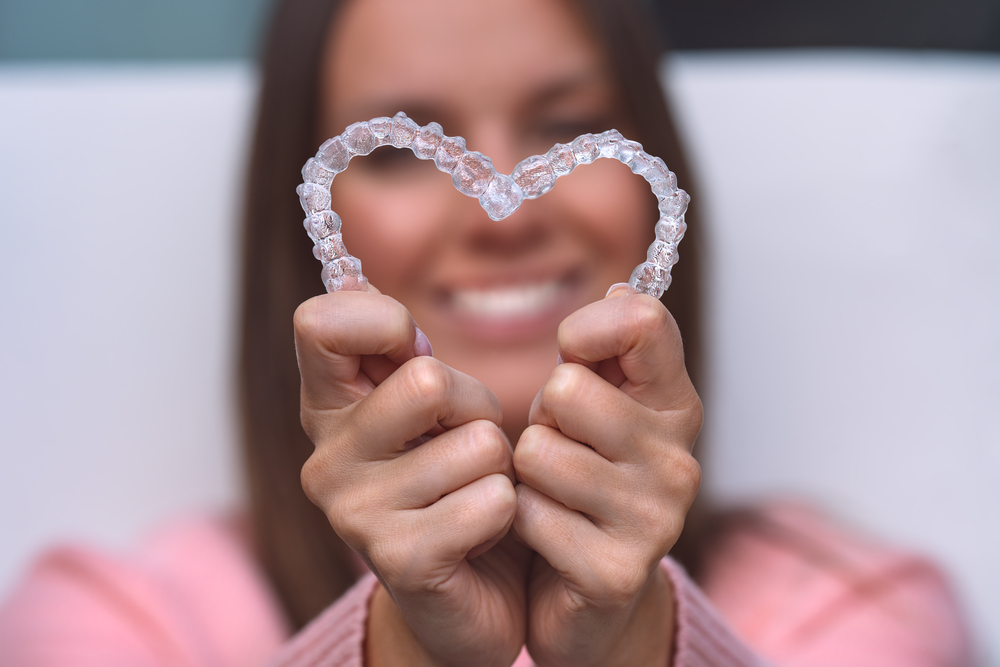If you have dental misalignment that you want to correct, you may ask, how does Invisalign work? Invisalign is an alternative to traditional braces that involves moving teeth with clear, removable aligners. This method is an effective treatment for certain dental issues, and it may work faster than braces for certain individuals.
How Does Invisalign Move the Teeth?
Invisalign uses customized clear trays that apply specific pressure to various angles of the teeth.
During the initial visit, the orthodontist will take a 3D image of your jaw and teeth. Based on this, they design a treatment plan for the most effective results. Part of this plan is generating a series of clear plastic aligners that you will wear.
These customized aligners fit snugly on your upper and lower teeth to apply a gentle pressure that moves the teeth into the desired pressure over time. Every one to two weeks, you will replace the current aligner with a slightly different one that continues to apply controlled pressure to further move the teeth.
What Conditions Can Invisalign Correct?
Invisalign is more effective with mild to moderate dental issues.
Common conditions that Invisalign may be appropriate for include:
- Minor to moderate teeth misalignments
- Overbite
- Crowded teeth
- Small gaps between teeth
- Open bite
Invisalign may not be as effective in more complex situations, such as severely misaligned and crowded teeth or severe bite issues involving the jaws.
How Fast Do Teeth Move With Invisalign?

The total correction time varies based on various factors, but the average range is between six and 18 months.
The biggest factor regarding how Invisalign works is the severity of the orthodontic issue. For minor misalignments and with consistent aligner usage, teeth may move into the desired position in a matter of months. For more complex issues, it may take one to two years.
Does Invisalign Make Your Teeth Completely Straight?
In many cases, Invisalign works to completely straighten the teeth, but certain factors may impede this.
With severe misalignments or a complicated bite issue, the gentle pressure of the Invisalign trays may not be strong enough to straighten the teeth to the desired position. In such a case, some people may choose braces instead, as they tend to be more effective in completely straightening teeth in complex dental issues.
What Affects How Well Invisalign Works?
Certain factors impact the end results of the Invisalign treatment.
Wearing the Aligners Consistently
Even if patients have relatively minor misalignments, they may not get the results they want if they do not exactly follow the recommendations laid out by the orthodontist. One of the benefits of Invisalign is that the aligners are removable, but this can also be a disadvantage if patients keep the trays out longer than they should.
To get the best results, patients need to wear the Invisalign trays for 20 to 22 hours every day. Removal should only occur for brushing and flossing, eating, drinking anything except water, and cleaning the aligners. Taking them out any more frequently can reduce the effectiveness or make it take much longer to achieve ideal results.
Proper Cleaning
When cleaning the aligners, it is important to follow the specific directions. For example, using water that is too hot can cause alterations to the flexible plastic, which affects the precise fit and may increase the total correction time.
Age
The age of the patient also impacts the results. Invisalign is popular for adults, as it is less obvious in the mouth than braces. However, the jaw and teeth of older patients are fully formed, which means they do not move as easily as the teeth of younger patients. Therefore, treatment may take longer.
Retainer Use
Just as with braces, patients who wear Invisalign must also wear retainers after completing treatment.
For the first two to six months, patients should plan to wear their retainer full-time, for at least 22 hours every day, to prevent the teeth from moving back into their original position before using Invisalign. After at least six months, the retainer should be worn nightly.
It takes around a year for the jawbone and teeth to stabilize. Once this occurs, patients can wear their retainers less often, such as three to five times a week. Not wearing the retainers consistently may result in a reversal of the Invisalign treatment results.
Who Is a Good Candidate for Invisalign?

Not all individuals are a good fit for Invisalign, which is why it is important to have a consultation with your orthodontist.
Straightforward Dental Issue
The best candidates for this orthodontic procedure are those who do not have complex dental conditions. Minor bite issues and teeth misalignments are ideal cases.
Good Oral Health and Hygiene
Orthodontists will not begin any treatment if the patient has tooth decay or gum issues. Patients must treat those dental conditions first.
Because the tightness of the clear trays traps food and bacteria to the teeth, practicing good oral hygiene throughout treatment is imperative. Fortunately, being able to remove the aligners makes it easier to brush and floss, but Invisalign may not be a recommendation if a patient has bad hygiene habits or is prone to getting cavities.
Responsible
Good candidates are responsible and will wear the aligners for at least 20 hours each day. When they do remove them, they clean them properly, keep track of them, and put them back on their teeth when it is time.
No Dental Implants or Bridges
Although other dental work, such as an implant or bridge, does not mean patients are unable to have Invisalign, there are limitations. Implants and bridges are unmovable, so Invisalign will only straighten the teeth around these. Ideally, it is often better to wait and get these after completing Invisalign treatment.
Who Should You Talk With About How Invisalign Works and if It Is Right for You?
Now that you understand the basics of how Invisalign works, you may have additional questions. If you live in the San Tan Valley area, we at Peterson Family Orthodontics are happy to sit down with you in a complimentary consultation and discuss the pros and cons of this treatment. Contact us today to schedule an appointment.

